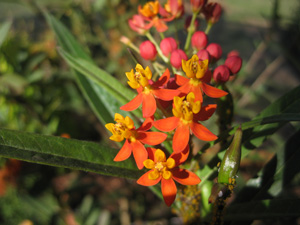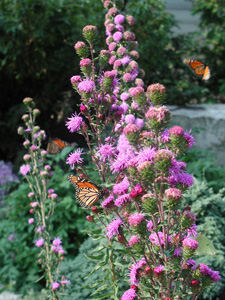Resource Library
Plant of the Week: Scarlet Milkweed
The University of Arkansas System Division of Agriculture does not promote, support or recommend plants featured in "Plant of the Week." Please consult your local Extension office for plants suitable for your region.
Plant of the Week
Scarlet Milkweed
Latin: Asclepias curassavica

Butterflies are all the rage in gardening today, with some likening them to flying flowers. These fluttering beauties make great examples for teachers because they expose students to the wonders of metamorphosis, which in itself can be used as a metaphor, as these young minds grow and change into the adults they will become. Additionally, butterflies are wonderful examples, showing the interdependence of life where almost all have evolved very specific and intricate relationships with their host plants.
Monarchs are undoubtedly the queens of the fairy ball, with good name recognition and even their own scientific society to study and observe them. These orange-and-black beauties have evolved an obligate relationship with milkweeds (Asclepias). The female monarchs seek out milkweed plants for egg-laying so that the caterpillars will have a plentiful supply of fodder as they fatten up for the metamorphosis, which will magically transform themselves into winged beauties. For the late summer and fall garden, one of the best milkweeds is Asclepias cruassavica, the scarlet milkweed or bloodflower.
Scarlet milkweed is a frost-tender evergreen shrub from land surrounding the Caribbean Basin that is grown as an annual in gardens. Plants reach 3 to 4 feet tall, with an upright form featuring several branches. The leaves are willow-shaped and to 5 inches long, and are often marred with signs of feeding by several kinds of insects. The stems and leaves exude a viscous white sap that causes a rash in sensitive individuals.
Flowers are produced at the ends of the stems in multi-flowered clusters to 4 inches across. Individual flowers are about a half-inch across, with five reflexed red petals and a yellow star-shaped crown (corona). Some selections are available with all yellow flowers. Milkweeds have three whorls in their floral envelope — the sepals, which are mostly small and insignificant; the petals, which usually are pushed backwards like the tail of a comet; and the protruding corona, which sets atop the petals in a distinct whorl.
Flowering is during the hottest part of the summer and into the fall until frost. The pinkie-shaped milkweed pod is to 4 inches long and filled with brown seeds, which are carried away on silken parachutes.
The relationship between monarchs and milkweeds is much studied. Milkweed plants produce cardenolides, a class of steroids that affect the heart. The bright colors of the caterpillar and the monarch itself are advertisements to birds about their toxic nature, and discourage most predators. The black swallowtail caterpillar has adopted mimicry as a defense strategy, and while not loaded with toxic compounds, looks a lot like a monarch caterpillar.

Scarlet milkweed is easy to grow in a sunny site having average garden soil. Adding it to the garden makes good sense, because all of our native milkweeds bloom before the first half of summer, and their foliage is often in bad shape by late summer. The flowers of the tropical exotic attract migrating monarchs and provide good grazing for the late-season crop of caterpillars. It makes a good filler plant in the mixed border or massed as a background planting. It is a bit too large to use very effectively in patio containers. Propagation is by seed saved late in the season or by easily rooted cuttings taken during periods of active growth. Plants will overwinter in zones 9 and 10.
Milkweeds are usually attacked by the orange milkweed aphids, which congregate at the ends of branches. There they line up shoulder-to-shoulder, like grazing cattle. Oftentimes the larger orange-and-black milkweed plant bug will also be present feeding on the pods. Neither of these insects is especially harmful to the plant, and spraying to control them is a really bad idea because it would probably poison the caterpillars.
By: Gerald Klingaman, retired
Retired Extension Horticulturist - Ornamentals
Extension News - October 7, 2011
The University of Arkansas System Division of Agriculture does not maintain lists of retail outlets where these plants can be purchased. Please check your local nursery or other retail outlets to ask about the availability of these plants for your growing area.